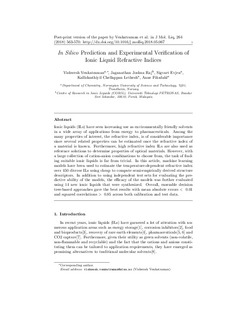| dc.contributor.author | Venkatraman, Vishwesh | |
| dc.contributor.author | Jaganathan, Joshua Raj | |
| dc.contributor.author | Evjen, Sigvart | |
| dc.contributor.author | Kallidanthiyil Chellappan, Lethesh | |
| dc.contributor.author | Fiksdahl, Anne | |
| dc.date.accessioned | 2019-04-04T10:20:34Z | |
| dc.date.available | 2019-04-04T10:20:34Z | |
| dc.date.created | 2018-05-23T10:59:34Z | |
| dc.date.issued | 2018 | |
| dc.identifier.citation | Journal of Molecular Liquids. 2018, 264 563-570. | nb_NO |
| dc.identifier.issn | 0167-7322 | |
| dc.identifier.uri | http://hdl.handle.net/11250/2593265 | |
| dc.description.abstract | Ionic liquids (ILs) have seen increasing use as environmentally friendly solvents in a wide array of applications from energy to pharmaceuticals. Among the many properties of interest, the refractive index, is of considerable importance since several related properties can be estimated once the refractive index of a material is known. Furthermore, high refractive index ILs are also used as reference solutions to determine properties of optical materials. However, with a large collection of cation-anion combinations to choose from, the task of finding suitable ionic liquids is far from trivial. In this article, machine learning models have been used to estimate the temperature-dependent refractive index over 450 diverse ILs using cheap to compute semi-empirically derived structure descriptors. In addition to using independent test sets for evaluating the predictive ability of the models, the efficacy of the models was further evaluated using 14 new ionic liquids that were synthesized. Overall, ensemble decision tree-based approaches gave the best results with mean absolute errors < 0.01 and squared correlations > 0.85 across both calibration and test data. | nb_NO |
| dc.language.iso | eng | nb_NO |
| dc.publisher | Elsevier | nb_NO |
| dc.rights | Attribution-NonCommercial-NoDerivatives 4.0 Internasjonal | * |
| dc.rights.uri | http://creativecommons.org/licenses/by-nc-nd/4.0/deed.no | * |
| dc.title | In silico prediction and experimental verification of ionic liquid refractive indices | nb_NO |
| dc.type | Journal article | nb_NO |
| dc.type | Peer reviewed | nb_NO |
| dc.description.version | acceptedVersion | nb_NO |
| dc.source.pagenumber | 563-570 | nb_NO |
| dc.source.volume | 264 | nb_NO |
| dc.source.journal | Journal of Molecular Liquids | nb_NO |
| dc.identifier.doi | 10.1016/j.molliq.2018.05.067 | |
| dc.identifier.cristin | 1586160 | |
| dc.relation.project | Norges forskningsråd: 233776 | nb_NO |
| dc.description.localcode | © 2018. This is the authors’ accepted and refereed manuscript to the article. Locked until 21.5.2020 due to copyright restrictions. This manuscript version is made available under the CC-BY-NC-ND 4.0 license http://creativecommons.org/licenses/by-nc-nd/4.0/ | nb_NO |
| cristin.unitcode | 194,66,25,0 | |
| cristin.unitname | Institutt for kjemi | |
| cristin.ispublished | true | |
| cristin.fulltext | original | |
| cristin.qualitycode | 1 | |

